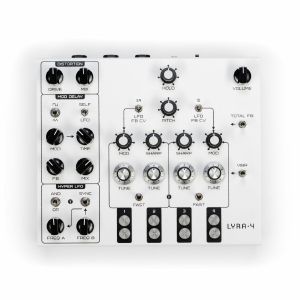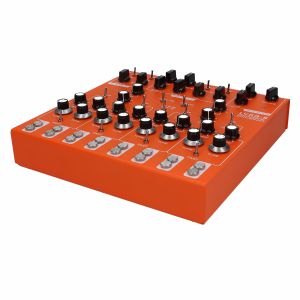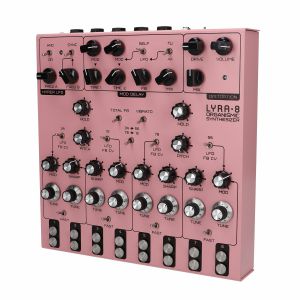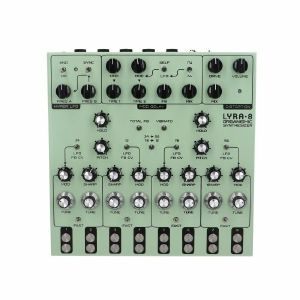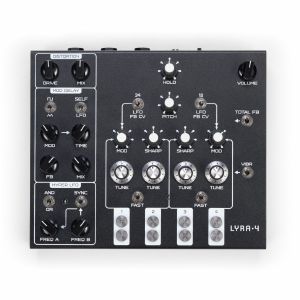Filter
ブランド
Featured
値段
タグ
シンセサイザー
Synthesisers – or synths – are the fundamental building blocks of most electronic music. Whether analogue or digital, a hardware synth is any instrument which generates sound using electronic circuits. Most of the great synths are keyboards, but there are a lot more choices, including desktop modules and modular systems.
Our range includes old-school analogue synthesisers and reissues of vintage classics, plus the latest digital workstations, patchable semi-modular instruments and portable models suitable for live performance or making music on the go.
With such a wide variety of synths on offer, there’s something to suit everyone, from budget options for beginners through to premium models for pro studios. Brands like Arturia, Korg and Roland offer excellent value for money, while the likes of Moog and Waldorf offer some of the best high-end options for those who want something a little more advanced.
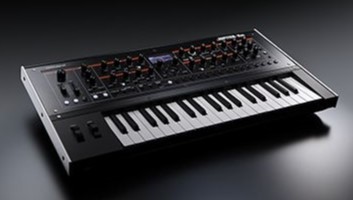
1~5/5(ページ1/1)の商品
SoMa Laboratory Lyra-4 4-Voice Organismic Analogue Synthesiser (white) (analogue desktop synthesiser)
Cat: 1055355 Rel: 31 Jan 25
4-voice organismic analogue synthesiser
Notes: Introducing the revived version of LYRA-4 organismic synthesiser, the younger sister of the famous LYRA-8. "Organismic" means that LYRA uses some principles that lie in the base of living organisms. The way how LYRA's modules interacting between each other and the behaviour of the instrument resembles a live conversation. It's smaller and weighs less but is equally rugged in design, and still packs a lot of punch. This makes it easy to fit in a backpack and perfect for taking the LYRA sound on the road. And playing two LYRA-4s can actually sound very different than just one LYRA-8.
LYRA-4 is based on four generators, which will be referred to as voices. Their design is not like a traditional subtractive synthesis VCO. Instead of having a linear or logarithmic dependency on control voltage, they resemble the tone generators in old electric organs. Hence the use of the term "voices" instead of "VCOs". Lyra uses non-linearity a lot, and the voices are constructed in such a way that allows for non-linearity to express itself.
The voices are divided into two pairs (12, 34), creating tree-like structure.
The voices can function either in an electric organ mode or in an FM synthesis mode with each of the voices and its envelope acting as a separate FM operator. The voice's impact on FM synthesis will decrease along with the decay of its envelope.
LYRA-4 also has the next blocks:
The HYPER LFO is a complex low-frequency generator, whose waveform is synthesized from two simple LFOs by summation or multiplication of their frequencies. It also has a sync mode. The LFO can modulate the selected pairs of voices and the MOD DELAY.
The MOD DELAY consists of delay with feedback. The delay has a unique possibility of self-modulation where the output signal modulates the delay sample rate, creating cool effects.
The DISTORTION is last in the chain, after the delay. It enables the delay to also influence the distortion.
For all its experimental character, LYRA is a professional instrument. Its output dynamics and frequency response are balanced and ready for a live performance or studio recording without any additional processing.
Specifications
Max output voltage: 2 v 0-to-peak
Output connector: mono 6.3 mm TS jack
Output resistance: 10 KOhm
CV DELAY: unipolar, range of 0 to +5 volt
CV DELAY: 6.3 mm TS jack
CV VOICES: unipolar, range of 0 to +5 volt
CV VOICES connector: 6.3 mm TS jack
Power supply: stabilised, +12 V, 0.2 A, centre positive
Power Consumption: 1.2 watt
Headphones resistance: 6-64 Ohm
Power supply: stabilised, +12 V, 0.2 A, centre positive
Dimensions: 241 x 203 x 62 mm
Weight (without power supply and packaging): 1.2 kg
What's included:
LYRA-4 - 1 pc
Power supply - 1 pc
… Read moreLYRA-4 is based on four generators, which will be referred to as voices. Their design is not like a traditional subtractive synthesis VCO. Instead of having a linear or logarithmic dependency on control voltage, they resemble the tone generators in old electric organs. Hence the use of the term "voices" instead of "VCOs". Lyra uses non-linearity a lot, and the voices are constructed in such a way that allows for non-linearity to express itself.
The voices are divided into two pairs (12, 34), creating tree-like structure.
The voices can function either in an electric organ mode or in an FM synthesis mode with each of the voices and its envelope acting as a separate FM operator. The voice's impact on FM synthesis will decrease along with the decay of its envelope.
LYRA-4 also has the next blocks:
The HYPER LFO is a complex low-frequency generator, whose waveform is synthesized from two simple LFOs by summation or multiplication of their frequencies. It also has a sync mode. The LFO can modulate the selected pairs of voices and the MOD DELAY.
The MOD DELAY consists of delay with feedback. The delay has a unique possibility of self-modulation where the output signal modulates the delay sample rate, creating cool effects.
The DISTORTION is last in the chain, after the delay. It enables the delay to also influence the distortion.
For all its experimental character, LYRA is a professional instrument. Its output dynamics and frequency response are balanced and ready for a live performance or studio recording without any additional processing.
Specifications
Max output voltage: 2 v 0-to-peak
Output connector: mono 6.3 mm TS jack
Output resistance: 10 KOhm
CV DELAY: unipolar, range of 0 to +5 volt
CV DELAY: 6.3 mm TS jack
CV VOICES: unipolar, range of 0 to +5 volt
CV VOICES connector: 6.3 mm TS jack
Power supply: stabilised, +12 V, 0.2 A, centre positive
Power Consumption: 1.2 watt
Headphones resistance: 6-64 Ohm
Power supply: stabilised, +12 V, 0.2 A, centre positive
Dimensions: 241 x 203 x 62 mm
Weight (without power supply and packaging): 1.2 kg
What's included:
LYRA-4 - 1 pc
Power supply - 1 pc
1 in stock $405.29
Soma Laboratory Lyra-8 8-Voice Organismic Analogue Synthesiser (orange) (analogue desktop synthesiser)
Cat: 1028791 Rel: 09 Jul 24
8-voice organismic analogue synthesiser
Notes: Welcome to the world of sound of LYRA-8, the unique organismic analogue synthesiser designed by Vlad Kreimer. "Organismic" means that LYRA uses some principles that lie in the base of living organisms. The way how LYRA's modules interacting between each other and the behaviour of the instrument resembles a live conversation.
LYRA-8 is based on eight generators, which will be referred to as voices. Their design is not like a traditional subtractive synthesis VCO. Instead of having a linear or logarithmic dependency on control voltage, they resemble the tone generators in old electric organs. Hence the use of the term "voices" instead of "VCOs". Lyra uses non-linearity a lot, and the voices are constructed in such a way that allows for non-linearity to express itself.
The voices are divided into four pairs (12, 34, 56, 78). All the pairs are divided in two groups, with two pairs in each (1234, 5678), creating tree-like structure.
The voices can function either in an electric organ mode or in an FM synthesis mode with each of the voices and its envelope acting as a separate FM operator. The voice's impact on FM synthesis will decrease along with the decay of its envelope.
LYRA-8 also has the next blocks:
The HYPER LFO is a complex low-frequency generator, whose waveform is synthesized from two simple LFOs by summation or multiplication of their frequencies. It also has a sync mode. The LFO can modulate the selected pairs of voices and the MOD DELAY.
The MOD DELAY consists of two lines of delay with cross-feedback and a special architecture that enables resonance between the two lines. Each line's delay time can be individually modulated from various sources, including external ones. The delay has a unique possibility of self-modulation where the output signal modulates the delay sample rate, creating cool effects.
The DISTORTION is last in the chain, after the delay. It enables the delay to also influence the distortion.
For all its experimental character, LYRA is a professional instrument. Its output dynamics and frequency response are balanced and ready for a live performance or studio recording without any additional processing.
… Read moreLYRA-8 is based on eight generators, which will be referred to as voices. Their design is not like a traditional subtractive synthesis VCO. Instead of having a linear or logarithmic dependency on control voltage, they resemble the tone generators in old electric organs. Hence the use of the term "voices" instead of "VCOs". Lyra uses non-linearity a lot, and the voices are constructed in such a way that allows for non-linearity to express itself.
The voices are divided into four pairs (12, 34, 56, 78). All the pairs are divided in two groups, with two pairs in each (1234, 5678), creating tree-like structure.
The voices can function either in an electric organ mode or in an FM synthesis mode with each of the voices and its envelope acting as a separate FM operator. The voice's impact on FM synthesis will decrease along with the decay of its envelope.
LYRA-8 also has the next blocks:
The HYPER LFO is a complex low-frequency generator, whose waveform is synthesized from two simple LFOs by summation or multiplication of their frequencies. It also has a sync mode. The LFO can modulate the selected pairs of voices and the MOD DELAY.
The MOD DELAY consists of two lines of delay with cross-feedback and a special architecture that enables resonance between the two lines. Each line's delay time can be individually modulated from various sources, including external ones. The delay has a unique possibility of self-modulation where the output signal modulates the delay sample rate, creating cool effects.
The DISTORTION is last in the chain, after the delay. It enables the delay to also influence the distortion.
For all its experimental character, LYRA is a professional instrument. Its output dynamics and frequency response are balanced and ready for a live performance or studio recording without any additional processing.
2 in stock $719.54
Soma Laboratory Lyra-8 8-Voice Organismic Analogue Synthesiser (pink) (analogue desktop synthesiser)
Cat: 1028799 Rel: 09 Jul 24
8-voice organismic analogue synthesiser
Notes: Pink version of Soma's excellent Lyra-8. Brilliantly unusual synth based on eight analogue tone generators, functioning more like an electric organ or FM synth than a conventional subtractive architecture. Unique sound.
Supplier's Notes:
Welcome to the world of sound of LYRA-8, the unique organismic analogue synthesiser designed by Vlad Kreimer. "Organismic" means that LYRA uses some principles that lie in the base of living organisms. The way how LYRA's modules interacting between each other and the behaviour of the instrument resembles a live conversation.
LYRA-8 is based on eight generators, which will be referred to as voices. Their design is not like a traditional subtractive synthesis VCO. Instead of having a linear or logarithmic dependency on control voltage, they resemble the tone generators in old electric organs. Hence the use of the term "voices" instead of "VCOs". Lyra uses non-linearity a lot, and the voices are constructed in such a way that allows for non-linearity to express itself.
The voices are divided into four pairs (12, 34, 56, 78). All the pairs are divided in two groups, with two pairs in each (1234, 5678), creating tree-like structure.
The voices can function either in an electric organ mode or in an FM synthesis mode with each of the voices and its envelope acting as a separate FM operator. The voice's impact on FM synthesis will decrease along with the decay of its envelope.
LYRA-8 also has the next blocks:
The HYPER LFO is a complex low-frequency generator, whose waveform is synthesized from two simple LFOs by summation or multiplication of their frequencies. It also has a sync mode. The LFO can modulate the selected pairs of voices and the MOD DELAY.
The MOD DELAY consists of two lines of delay with cross-feedback and a special architecture that enables resonance between the two lines. Each line's delay time can be individually modulated from various sources, including external ones. The delay has a unique possibility of self-modulation where the output signal modulates the delay sample rate, creating cool effects.
The DISTORTION is last in the chain, after the delay. It enables the delay to also influence the distortion.
For all its experimental character, LYRA is a professional instrument. Its output dynamics and frequency response are balanced and ready for a live performance or studio recording without any additional processing.
… Read moreSupplier's Notes:
Welcome to the world of sound of LYRA-8, the unique organismic analogue synthesiser designed by Vlad Kreimer. "Organismic" means that LYRA uses some principles that lie in the base of living organisms. The way how LYRA's modules interacting between each other and the behaviour of the instrument resembles a live conversation.
LYRA-8 is based on eight generators, which will be referred to as voices. Their design is not like a traditional subtractive synthesis VCO. Instead of having a linear or logarithmic dependency on control voltage, they resemble the tone generators in old electric organs. Hence the use of the term "voices" instead of "VCOs". Lyra uses non-linearity a lot, and the voices are constructed in such a way that allows for non-linearity to express itself.
The voices are divided into four pairs (12, 34, 56, 78). All the pairs are divided in two groups, with two pairs in each (1234, 5678), creating tree-like structure.
The voices can function either in an electric organ mode or in an FM synthesis mode with each of the voices and its envelope acting as a separate FM operator. The voice's impact on FM synthesis will decrease along with the decay of its envelope.
LYRA-8 also has the next blocks:
The HYPER LFO is a complex low-frequency generator, whose waveform is synthesized from two simple LFOs by summation or multiplication of their frequencies. It also has a sync mode. The LFO can modulate the selected pairs of voices and the MOD DELAY.
The MOD DELAY consists of two lines of delay with cross-feedback and a special architecture that enables resonance between the two lines. Each line's delay time can be individually modulated from various sources, including external ones. The delay has a unique possibility of self-modulation where the output signal modulates the delay sample rate, creating cool effects.
The DISTORTION is last in the chain, after the delay. It enables the delay to also influence the distortion.
For all its experimental character, LYRA is a professional instrument. Its output dynamics and frequency response are balanced and ready for a live performance or studio recording without any additional processing.
1 in stock $697.34
SoMa Laboratory Lyra-8 8-Voice Organismic Analogue Synthesiser (green) (analogue desktop synthesiser)
Cat: 1028772 Rel: 08 Jul 24
8-voice organismic analogue synthesiser
Notes: Welcome to the world of sound of LYRA-8, the unique organismic analogue synthesiser designed by Vlad Kreimer. "Organismic" means that LYRA uses some principles that lie in the base of living organisms. The way how LYRA's modules interacting between each other and the behaviour of the instrument resembles a live conversation.
LYRA-8 is based on eight generators, which will be referred to as voices. Their design is not like a traditional subtractive synthesis VCO. Instead of having a linear or logarithmic dependency on control voltage, they resemble the tone generators in old electric organs. Hence the use of the term "voices" instead of "VCOs". Lyra uses non-linearity a lot, and the voices are constructed in such a way that allows for non-linearity to express itself.
The voices are divided into four pairs (12, 34, 56, 78). All the pairs are divided in two groups, with two pairs in each (1234, 5678), creating tree-like structure.
The voices can function either in an electric organ mode or in an FM synthesis mode with each of the voices and its envelope acting as a separate FM operator. The voice's impact on FM synthesis will decrease along with the decay of its envelope.
LYRA-8 also has the next blocks:
The HYPER LFO is a complex low-frequency generator, whose waveform is synthesized from two simple LFOs by summation or multiplication of their frequencies. It also has a sync mode. The LFO can modulate the selected pairs of voices and the MOD DELAY.
The MOD DELAY consists of two lines of delay with cross-feedback and a special architecture that enables resonance between the two lines. Each line's delay time can be individually modulated from various sources, including external ones. The delay has a unique possibility of self-modulation where the output signal modulates the delay sample rate, creating cool effects.
The DISTORTION is last in the chain, after the delay. It enables the delay to also influence the distortion.
For all its experimental character, LYRA is a professional instrument. Its output dynamics and frequency response are balanced and ready for a live performance or studio recording without any additional processing.
Specifications:
Max output voltage: 2 v 0-to-peak
Output connector: mono 6.3 mm TS or TRS (balanced) jack
Output resistance: 100 Ohm
EXT IN: 1 v 0-to-peak
EXT IN connector: 6.3 mm TS jack
HOLD GATE: full HOLD volume +5 V
HOLD GATE connector: 6.3 mm TS jack
CV DELAY : unipolar, range of 0 to +5 volt
CV DELAY connector: 6.3 mm TS jack
CV VOICES: unipolar, range of 0 to +5 volt
CV VOICES connector: 6.3 mm TS jack
Power supply: stabilised, +12 V, 0.2 A, centre positive
Power Consumption: 2 watt
Dimensions: 266 x 266 x 62 mm
Weight (without power supply and packaging): 2.5 kg
… Read moreLYRA-8 is based on eight generators, which will be referred to as voices. Their design is not like a traditional subtractive synthesis VCO. Instead of having a linear or logarithmic dependency on control voltage, they resemble the tone generators in old electric organs. Hence the use of the term "voices" instead of "VCOs". Lyra uses non-linearity a lot, and the voices are constructed in such a way that allows for non-linearity to express itself.
The voices are divided into four pairs (12, 34, 56, 78). All the pairs are divided in two groups, with two pairs in each (1234, 5678), creating tree-like structure.
The voices can function either in an electric organ mode or in an FM synthesis mode with each of the voices and its envelope acting as a separate FM operator. The voice's impact on FM synthesis will decrease along with the decay of its envelope.
LYRA-8 also has the next blocks:
The HYPER LFO is a complex low-frequency generator, whose waveform is synthesized from two simple LFOs by summation or multiplication of their frequencies. It also has a sync mode. The LFO can modulate the selected pairs of voices and the MOD DELAY.
The MOD DELAY consists of two lines of delay with cross-feedback and a special architecture that enables resonance between the two lines. Each line's delay time can be individually modulated from various sources, including external ones. The delay has a unique possibility of self-modulation where the output signal modulates the delay sample rate, creating cool effects.
The DISTORTION is last in the chain, after the delay. It enables the delay to also influence the distortion.
For all its experimental character, LYRA is a professional instrument. Its output dynamics and frequency response are balanced and ready for a live performance or studio recording without any additional processing.
Specifications:
Max output voltage: 2 v 0-to-peak
Output connector: mono 6.3 mm TS or TRS (balanced) jack
Output resistance: 100 Ohm
EXT IN: 1 v 0-to-peak
EXT IN connector: 6.3 mm TS jack
HOLD GATE: full HOLD volume +5 V
HOLD GATE connector: 6.3 mm TS jack
CV DELAY : unipolar, range of 0 to +5 volt
CV DELAY connector: 6.3 mm TS jack
CV VOICES: unipolar, range of 0 to +5 volt
CV VOICES connector: 6.3 mm TS jack
Power supply: stabilised, +12 V, 0.2 A, centre positive
Power Consumption: 2 watt
Dimensions: 266 x 266 x 62 mm
Weight (without power supply and packaging): 2.5 kg
2 in stock $697.34
SoMa Laboratory Lyra-4 4-Voice Organismic Analogue Synthesiser (black) (analogue desktop synthesiser)
Cat: 1055354 Rel: 31 Jan 25
4-voice organismic analogue synthesiser
Notes: Derived from the excellent Lyra-8, the Lyra-4 features a similar 'organismic' approach to synthesis. Four-voice non-linear architecture offers unique tones in a compact, portable format.
Supplier's Notes:
Introducing the revived version of LYRA-4 organismic synthesiser, the younger sister of the famous LYRA-8. "Organismic" means that LYRA uses some principles that lie in the base of living organisms. The way how LYRA's modules interacting between each other and the behaviour of the instrument resembles a live conversation. It's smaller and weighs less but is equally rugged in design, and still packs a lot of punch. This makes it easy to fit in a backpack and perfect for taking the LYRA sound on the road. And playing two LYRA-4s can actually sound very different than just one LYRA-8.
LYRA-4 is based on four generators, which will be referred to as voices. Their design is not like a traditional subtractive synthesis VCO. Instead of having a linear or logarithmic dependency on control voltage, they resemble the tone generators in old electric organs. Hence the use of the term "voices" instead of "VCOs". Lyra uses non-linearity a lot, and the voices are constructed in such a way that allows for non-linearity to express itself.
The voices are divided into two pairs (12, 34), creating tree-like structure.
The voices can function either in an electric organ mode or in an FM synthesis mode with each of the voices and its envelope acting as a separate FM operator. The voice's impact on FM synthesis will decrease along with the decay of its envelope.
LYRA-4 also has the next blocks:
The HYPER LFO is a complex low-frequency generator, whose waveform is synthesized from two simple LFOs by summation or multiplication of their frequencies. It also has a sync mode. The LFO can modulate the selected pairs of voices and the MOD DELAY.
The MOD DELAY consists of delay with feedback. The delay has a unique possibility of self-modulation where the output signal modulates the delay sample rate, creating cool effects.
The DISTORTION is last in the chain, after the delay. It enables the delay to also influence the distortion.
For all its experimental character, LYRA is a professional instrument. Its output dynamics and frequency response are balanced and ready for a live performance or studio recording without any additional processing.
Specifications
Max output voltage: 2 v 0-to-peak
Output connector: mono 6.3 mm TS jack
Output resistance: 10 KOhm
CV DELAY: unipolar, range of 0 to +5 volt
CV DELAY: 6.3 mm TS jack
CV VOICES: unipolar, range of 0 to +5 volt
CV VOICES connector: 6.3 mm TS jack
Power supply stabilised, +12 V, 0.2 A, centre positive
Power Consumption: 1.2 watt
Headphones resistance: 6-64 Ohm
Power supply stabilised, +12 V, 0.2 A, centre positive
Dimensions: 241 x 203 x 62 mm
Weight (without power supply and packaging): 1.2 kg
What's included:
LYRA-4 - 1 pc
Power supply - 1 pc
… Read moreSupplier's Notes:
Introducing the revived version of LYRA-4 organismic synthesiser, the younger sister of the famous LYRA-8. "Organismic" means that LYRA uses some principles that lie in the base of living organisms. The way how LYRA's modules interacting between each other and the behaviour of the instrument resembles a live conversation. It's smaller and weighs less but is equally rugged in design, and still packs a lot of punch. This makes it easy to fit in a backpack and perfect for taking the LYRA sound on the road. And playing two LYRA-4s can actually sound very different than just one LYRA-8.
LYRA-4 is based on four generators, which will be referred to as voices. Their design is not like a traditional subtractive synthesis VCO. Instead of having a linear or logarithmic dependency on control voltage, they resemble the tone generators in old electric organs. Hence the use of the term "voices" instead of "VCOs". Lyra uses non-linearity a lot, and the voices are constructed in such a way that allows for non-linearity to express itself.
The voices are divided into two pairs (12, 34), creating tree-like structure.
The voices can function either in an electric organ mode or in an FM synthesis mode with each of the voices and its envelope acting as a separate FM operator. The voice's impact on FM synthesis will decrease along with the decay of its envelope.
LYRA-4 also has the next blocks:
The HYPER LFO is a complex low-frequency generator, whose waveform is synthesized from two simple LFOs by summation or multiplication of their frequencies. It also has a sync mode. The LFO can modulate the selected pairs of voices and the MOD DELAY.
The MOD DELAY consists of delay with feedback. The delay has a unique possibility of self-modulation where the output signal modulates the delay sample rate, creating cool effects.
The DISTORTION is last in the chain, after the delay. It enables the delay to also influence the distortion.
For all its experimental character, LYRA is a professional instrument. Its output dynamics and frequency response are balanced and ready for a live performance or studio recording without any additional processing.
Specifications
Max output voltage: 2 v 0-to-peak
Output connector: mono 6.3 mm TS jack
Output resistance: 10 KOhm
CV DELAY: unipolar, range of 0 to +5 volt
CV DELAY: 6.3 mm TS jack
CV VOICES: unipolar, range of 0 to +5 volt
CV VOICES connector: 6.3 mm TS jack
Power supply stabilised, +12 V, 0.2 A, centre positive
Power Consumption: 1.2 watt
Headphones resistance: 6-64 Ohm
Power supply stabilised, +12 V, 0.2 A, centre positive
Dimensions: 241 x 203 x 62 mm
Weight (without power supply and packaging): 1.2 kg
What's included:
LYRA-4 - 1 pc
Power supply - 1 pc
1 in stock $405.29
1~5/5(ページ1/1)の商品

 USD
USD





